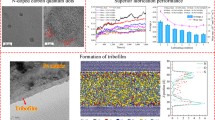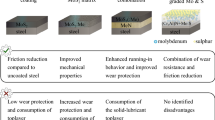Abstract
Nonequilibrium molecular dynamics (NEMD) simulations were performed to investigate the tribology behaviors of Al2O3 and MoS2 nanoparticles confined between iron (Fe) slabs. Results indicated that the combined use of these two nanoparticles yielded the lowest and most stable friction force, normal force, interface temperature and wear rate, which exhibited a significant synergistic lubrication effect. A novel parameter the rolling/sliding motion coefficient (Krs) was proposed to evaluate the motion pattern of spherical Al2O3. There were 51% rolling + 49% sliding motion when used alone and 91% rolling + 9% sliding in the existence of MoS2. Similarly, about 72.3% of the friction was shared by interlayer sliding of MoS2 monolayers in the presence of Al2O3, which was higher than used alone (54.8%). Then, the diffusion of atoms at the friction interface was explored to reveal the synergistic lubrication mechanism. The tribofilm formed by the diffusion of Fe and S atoms could protect the metal surfaces from further wear. The adsorption of S atoms to Al2O3 nanoparticle could promote its rolling effect and prevent it from embedding into iron matrix. Besides, Al2O3 could also facilitate the separation of MoS2 monolayers to enhance their interlayer sliding effect.










Similar content being viewed by others
References
Wang W, Zhang G, Xie G (2019) Ultralow concentration of graphene oxide nanosheets as oil-based lubricant additives. Appl Surf Sci 498:143683. https://doi.org/10.1016/j.apsusc.2019.143683
Han X, Zhang Z, Thrush SJ, Barber GC, Qu H (2020) Ionic liquid stabilized nanoparticle additive in a steel-ceramic contact for extreme pressure application. Wear 452–453:203264. https://doi.org/10.1016/j.wear.2020.203264
Wu H, Zhao J, Xia W, Cheng X, He A, Yun JH, Wang L, Huang H, Jiao S, Huang L, Zhang S, Jiang Z (2017) Analysis of TiO2 nano-additive water-based lubricants in hot rolling of microalloyed steel. J Manuf Process 27:26–36. https://doi.org/10.1016/j.jmapro.2017.03.011
Liu C, Friedman O, Li Y, Li S, Tian Y, Golan Y, Meng Y (2019) Electric response of CuS nanoparticle lubricant additives: the effect of crystalline and amorphous octadecylamine surfactant capping layers. Langmuir 35:15825–15833. https://doi.org/10.1021/acs.langmuir.9b01714
Jiang Z, Zhang Y, Yang G, Gao C, Yu L, Zhang S, Zhang P (2019) Synthesis of oil-soluble WS2 nanosheets under mild condition and study of their effect on tribological properties of poly-alpha olefin under evaluated temperatures. Tribol Int 138:68–78. https://doi.org/10.1016/j.triboint.2019.05.036
Xie H, Dang S, Jiang B, Xiang L, Zhou S, Sheng H, Yang T, Pan F (2019) Tribological performances of SiO2/graphene combinations as water-based lubricant additives for magnesium alloy rolling. Appl Surf Sci 475:847–856. https://doi.org/10.1016/j.apsusc.2019.01.062
He J, Sun J, Meng Y, Yan X (2019) Preliminary investigations on the tribological performance of hexagonal boron nitride nanofluids as lubricant for steel/steel friction pairs. Surf Topogr-Metrol 7:015022. https://doi.org/10.1088/2051-672X/ab0afb
Ashour ME, Osman TA, Khattab A, Elshalakny AB (2017) Novel tribological behavior of hybrid MWCNTs/MLNGPs as an additive on lithium grease. J Tribol 139:041801. https://doi.org/10.1115/1.4035345
Xiong S, Liang D, Wu H, Zhang B (2020) Synthesis, characterisation, and tribological evaluation of Mn3B7O13Cl nanoparticle as efficient antiwear lubricant in the sliding wear between tantalum strips and steel ball. Lubr Sci 32:121–130. https://doi.org/10.1002/ls.1491
Ghaednia H, Babaei H, Jackson RL, Bozack MJ, Khodadadi JM (2013) The effect of nanoparticles on thin film elasto-hydrodynamic lubrication. Appl Phys Lett 103:263111. https://doi.org/10.1063/1.4858485
Kao M-J, Lin C-R (2009) Evaluating the role of spherical titanium oxide nanoparticles in reducing friction between two pieces of cast iron. J Alloy Compd 483:456–459. https://doi.org/10.1016/j.jallcom.2008.07.223
Lee K, Hwang Y, Cheong S, Choi Y, Kwon L, Lee J, Kim SH (2009) Understanding the role of nanoparticles in nano-oil lubrication. Tribol Lett 35(2):127–131. https://doi.org/10.1007/s11249-009-9441-7
Bao Y, Sun J, Kong L (2017) Effects of nano-SiO2 as water-based lubricant additive on surface qualities of strips after hot rolling. Tribol Int 114:257–263. https://doi.org/10.1016/j.triboint.2017.04.026
Luo T, Wang P, Qiu Z, Yang S, Zeng H, Cao B (2016) Smooth and solid WS2 submicrospheres grown by a new laser fragmentation and reshaping process with enhanced tribological properties. Chem Commun 52:10147–10150. https://doi.org/10.1039/c6cc04212k
Roy S, Jazaa Y, Sundararajan S (2019) Investigating the micropitting and wear performance of copper oxide and tungsten carbide nanofluids under boundary lubrication. Wear 428–429:55–63. https://doi.org/10.1016/j.wear.2019.03.007
Wu P, Chen X, Zhang C, Luo J (2019) Synergistic tribological behaviors of graphene oxide and nanodiamond as lubricating additives in water. Tribol Int 132:177–184. https://doi.org/10.1016/j.triboint.2018.12.021
Wang S, Zhou S, Huang J, Zhao G, Liu Y (2019) Attaching ZrO2 nanoparticles onto the surface of graphene oxide via electrostatic self-assembly for enhanced mechanical and tribological performance of phenolic resin composites. J Mater Sci 54:8247–8261. https://doi.org/10.1007/s10853-019-03512-w
Sharma AK, Singh RK, Dixit AR, Tiwari AK (2017) Novel uses of alumina-MoS2 hybrid nanoparticle enriched cutting fluid in hard turning of AISI 304 steel. J Manuf Process 30:467–482. https://doi.org/10.1016/j.jmapro.2017.10.016
He J, Sun J, Meng Y, Pei Y (2020) Superior lubrication performance of MoS2–Al2O3 composite nanofluid in strips hot rolling. J Manuf Process 57:312–323. https://doi.org/10.1016/j.jmapro.2020.06.037
Ewen JP, Heyes DM, Dini D (2018) Advances in nonequilibrium molecular dynamics simulations of lubricants and additives. Friction 6:349–386. https://doi.org/10.1007/s40544-018-0207-9
Ewen JP, Gattinoni C, Thakkar FM, Morgan N, Spikes HA, Dini D (2016) Nonequilibrium molecular dynamics investigation of the reduction in friction and wear by carbon nanoparticles between iron surfaces. Tribol Lett 63:38–52. https://doi.org/10.1007/s11249-016-0722-7
Su LL, Krin J, Brenner DW (2020) Dynamics of neutral and charged nanodiamonds in aqueous media confined between gold surfaces under normal and shear loading. ACS Omega 5(18):10349–10358. https://doi.org/10.1021/acsomega.0c00073
Shi J, Fang L, Sun K (2018) Friction and wear reduction via tuning nanoparticle shape under low humidity conditions: a nonequilibrium molecular dynamics simulation. Comput Mater Sci 154:499–507. https://doi.org/10.1016/j.commatsci.2018.06.043
Onodera T, Morita Y, Suzuki A et al (2009) A computational chemistry study on friction of h-MoS2. Part I. Mechanism of single sheet lubrication. J Phys Chem B 113(52):16526–16536. https://doi.org/10.1021/jp9069866
Hu C, Yi C, Bai M, Lv J, Tang D (2020) Molecular dynamics study of the frictional properties of multilayer MoS2. RSC Adv 10:17418–17426. https://doi.org/10.1039/d0ra00995d
Plimpton S (1995) Fast parallel algorithms for short-range molecular dynamics. J Comput Phys 117:1–19. https://doi.org/10.1006/jcph.1995.1039
Evans DJ, Holian BL (1998) The Nose–Hoover thermostat. J Chem Phys 83:4069–4074. https://doi.org/10.1063/1.449071
Sam A, Kannam SK, Hartkamp R, Sathian SP (2017) Water flow in carbon nanotubes: the effect of tube flexibility and thermostat. J Chem Phys 146:234701. https://doi.org/10.1063/1.4985252
Tang Z, Li S (2014) A review of recent developments of friction modifiers for liquid lubricants (2007–present). Curr Opin Solid State Mater Sci 18:119–139. https://doi.org/10.1016/j.cossms.2014.02.002
Hu C, Bai M, Lv J, Liu H, Li X (2014) Molecular dynamics investigation of the effect of copper nanoparticle on the solid contact between friction surfaces. Appl Surf Sci 321:302–309. https://doi.org/10.1016/j.apsusc.2014.10.006
Chen KY, Liu HB, Li XP, Han QY, Hu ZQ (1995) Molecular dynamics simulation of local structure of aluminium and copper in supercooled liquid and solid state by using EAM. J Phys-Condens Matter 7:2379–2394. https://doi.org/10.1088/0953-8984/7/12/003
Johnson RA, Oh DJ (1989) Analytic embedded atom method model for bcc metals. J Mater Res 4:1195–1201. https://doi.org/10.1557/JMR.1989.1195
Erdemir A, Eryilmaz O (2014) Achieving superlubricity in DLC films by controlling bulk, surface, and tribochemistry. Friction 2:140–155. https://doi.org/10.1007/s40544-014-0055-1
Wu L, Keer LM, Lu J, Song B, Gu L (2018) Molecular dynamics simulations of the rheological properties of graphene–PAO nanofluids. J Mater Sci 53:15969–15976. https://doi.org/10.1007/s10853-018-2756-8
Rappe AK, Casewit CJ, Colwell KS, Goddard WA, Skiff WM (1992) UFF, a full periodic table force field for molecular mechanics and molecular dynamics simulations. J Am Chem Soc 114:10024–10035. https://doi.org/10.1021/ja00051a040
Farahani H, Rajabpour A, Khanaki M, Reyhani A (2018) Interfacial thermal resistance between few-layer MoS2 and silica substrates: a molecular dynamics study. Comput Mater Sci 142:1–6. https://doi.org/10.1016/j.commatsci.2017.09.052
Zhao W, Duan F (2020) Friction properties of carbon nanoparticles (nanodiamond and nanoscroll) confined between DLC and a-SiO2 surfaces. Tribol Int 145:106153. https://doi.org/10.1016/j.triboint.2019.106153
Diana B, Sanket AD, Subramanian KS, Ali E, Anirudha VS (2015) Macroscale superlubricity enabled by graphene nanoscroll formation. Science 348:1118–1122. https://doi.org/10.1126/science.1262024
Tuckerman M, Berne BJ, Martyna GJ (1992) Reversible multiple time scale molecular dynamics. J Chem Phys 97:1990–2001. https://doi.org/10.1063/1.463137
Sammaiah P, Ashwini V, Suresh A, Sushanth C, Sudheer Kumar N (2018) Analysis of Al2O3 nano particles and its deposition on steel by cold spray process. Mater Today Proc 5:20535–20543. https://doi.org/10.1016/j.matpr.2018.06.431
Kumari S, Chouhan A, Sharma OP et al (2020) Structural-defect-mediated grafting of alkylamine on few-layer MoS2 and its potential for enhancement of tribological properties. ACS Appl Mater Interfaces 12:30720–30730. https://doi.org/10.1021/acsami.0c08307
Hu C, Bai M, Lv J, Kou Z, Li X (2015) Molecular dynamics simulation on the tribology properties of two hard nanoparticles (diamond and silicon dioxide) confined by two iron blocks. Tribol Int 90:297–305. https://doi.org/10.1016/j.triboint.2015.04.043
Berro H, Fillot N, Vergne P, Tokumasu T, Ohara T, Kikugawa G (2011) Energy dissipation in non-isothermal molecular dynamics simulations of confined liquids under shear. J Chem Phys 135:134708. https://doi.org/10.1063/1.3644938
Ewen JP, Gao H, Muser MH, Dini D (2019) Shear heating, flow, and friction of confined molecular fluids at high pressure. Phys Chem Chem Phys 21:5813–5823. https://doi.org/10.1039/c8cp07436d
Gattinoni C, Heyes DM, Lorenz CD, Dini D (2013) Traction and nonequilibrium phase behavior of confined sheared liquids at high pressure. Phys Rev E 88:052406. https://doi.org/10.1103/PhysRevE.88.052406
Huang Y, Liu L, Yang J, Chen Y (2019) Nanotribological properties of ALD-made ultrathin MoS2 influenced by film thickness and scanning velocity. Langmuir 35:3651–3657. https://doi.org/10.1021/acs.langmuir.8b03970
Berman D, Mutyala KC, Srinivasan S, Sankaranarayanan SS, Erdemir A, Shevchenko EV, Sumant AV (2019) Iron-nanoparticle driven tribochemistry leading to superlubric sliding interfaces. Adv Mater Interfaces 6:1901416. https://doi.org/10.1002/admi.201901416
Joly-Pottuz L, Bucholz EW, Matsumoto N, Phillpot SR, Sinnott SB, Ohmae N, Martin JM (2009) Friction properties of carbon nano-onions from experiment and computer simulations. Tribol Lett 37:75–81. https://doi.org/10.1007/s11249-009-9492-9
Upadhyay RK, Kumar A (2019) Effect of humidity on the synergy of friction and wear properties in ternary epoxy-graphene-MoS2 composites. Carbon 146:717–727. https://doi.org/10.1016/j.carbon.2019.02.015
Maruda RW, Krolczyk GM, Feldshtein E, Nieslony P, Tyliszczak B, Pusavec F (2017) Tool wear characterizations in finish turning of AISI 1045 carbon steel for MQCL conditions. Wear 372–373:54–67. https://doi.org/10.1016/j.wear.2016.12.006
Kim HJ, Kim WK, Falk ML, Rigney DA (2007) MD simulations of microstructure evolution during high-velocity sliding between crystalline materials. Tribol Lett 28:299–306. https://doi.org/10.1007/s11249-007-9273-2
He A, Huang S, Yun J-H, el al, (2017) Tribological performance and lubrication mechanism of alumina nanoparticle water-based suspensions in ball-on-three-plate testing. Tribol Lett 65:40–50. https://doi.org/10.1007/s11249-017-0823-y
Xiong S, Sun J, Xu Y, Yan X, Li Y (2016) Tribological performance and wear mechanism of compound containing S, P, and B as EP/AW additives in copper foil oil. Tribol T 59:421–427. https://doi.org/10.1080/10402004.2015.1083066
Zhang Y, Feng K, Shui Y (2019) Effect of MoS2 on iron-based friction material prepared directly from vanadium-bearing titanomagnetite concentrates. Met Mater Int 26:1070–1078. https://doi.org/10.1007/s12540-019-00374-4
Sidashov AV, Kozakov AT, Yares’ko SI, Kakovkina NG, Manturov DS (2020) Study of the phase composition and tribological properties of carbon tool steels after laser surface hardening by quasi-CW fiber laser. Surf Coat Technol 385:125472. https://doi.org/10.1016/j.surfcoat.2020.125427
Su Y, Song J, Zhang Y, Fan H, Hu L (2019) Influence of fiber diameters on fracture and tribological properties of Al2O3/MoS2 fibrous monolithic ceramic. Tribol Int 138:32–39. https://doi.org/10.1016/j.triboint.2019.05.018
Acknowledgements
The work was supported by National Natural Science Foundation of China (No. 51874036), Beijing Municipal Natural Science Foundation (No. 2182041) and Beijing Municipal Education Commission (No. KM201911417002).
Author information
Authors and Affiliations
Corresponding author
Ethics declarations
Conflict of interest
All authors declare that they have no conflict of interest.
Additional information
Handling Editor: Yaroslava Yingling.
Publisher's Note
Springer Nature remains neutral with regard to jurisdictional claims in published maps and institutional affiliations.
Rights and permissions
About this article
Cite this article
He, J., Sun, J., Meng, Y. et al. Synergistic lubrication effect of Al2O3 and MoS2 nanoparticles confined between iron surfaces: a molecular dynamics study. J Mater Sci 56, 9227–9241 (2021). https://doi.org/10.1007/s10853-021-05889-z
Received:
Accepted:
Published:
Issue Date:
DOI: https://doi.org/10.1007/s10853-021-05889-z




